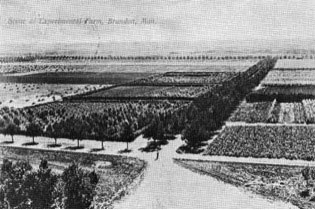HOME
1. Introduction
2. Historical Overview
3. A Scientific Approach: Experimental
and
Demonstration Farms
4.
The Greening of the West
by Lyle Dick,
Parks Canada
5. The Lyleton Area
Shelterbelts
6. The Indian Head
Shelterbelt Centre
7. The P.F.R.A
8. The Gerald Malaher
Wildlife
Management Area
9. Arbor Day & Tree Stories
10. Shelterbelts and Modern Agriculture
11. Links & Resources
|
4. The Greening of the
West:
Horticulture on the Canadian Prairies,
1870-1930
by Lyle
Dick
Parks Canada, Victoria, BC
Manitoba
History, Number 31, Spring 1996
Early
horticultural efforts after Confederation often focused on tree
culture in both Manitoba and the North-West Territories (after 1905,
Saskatchewan and Alberta). In this vast, often sparsely treed region,
settlers planted trees for a variety of reasons, including aesthetic
enhancement, protection of their farmsteads from wind, and for
psychological security.
Tree
culture also enabled the creation of farmstead microclimates
within which gardens could flourish. Among the earliest groups to plant
trees were Mennonites from Ukraine who settled in southern Manitoba
after 1874. These newcomers established agricultural street villages,
which they lined with cottonwoods transplanted from nearby riverbanks.
In, so doing they demonstrated the viability of tree culture in areas
of open prairie. By 1883 Manitoba’s 9,077 farmers were cultivating
120,000 hectares of land, of which 1,400 hectares were devoted to
gardens and orchards. The importance of tree culture was officially
recognized with the proclamation of Arbor Day in the North-West
Territories in 1884, followed by Manitoba in 1886.
The
systematic horticultural development of rural areas was an
ancillary goal of Dominion experimental farms in the settlement period.
The Dominion government, whose National Policy initiated a coordinated
program of immigration, railroad construction, and settlement on the
prairies, viewed forestry and horticulture, as well as field crops, as
essential to sustained settlement. Accordingly, federal authorities
established experimental farms at Brandon, Manitoba and Indian Head,
Saskatchewan, in the late 1880s. In addition to cereal grain and
livestock trials, the farms tested a wide variety of tree and plant
material originating in central Canada, the northern United States,
and Eurasia. In Alberta the first federal agricultural research station
was established at Lethbridge in 1906. Its experimental work included
comparative tests on both irrigated and non-irrigated land to determine
the potential for cultivating a broad range of plant material within
the dry belt. In 1915 the Dominion government established the first
prairie research station devoted primarily to horticulture, at Morden,
Manitoba. Its staff carried out extensive trials in small fruits,
trees, vegetables, and ornamentals, and disseminated the results to the
farm community.
 Shelter
belts and tree-lined approach, Dominion Experimental Farm,
Brandon, circa 1905.
Source: Archives of Manitoba
Shelter
belts and tree-lined approach, Dominion Experimental Farm,
Brandon, circa 1905.
Source: Archives of Manitoba
An early role of the experimental farms was the promotion of tree
shelterbelt plantations on farmsteads to create microclimates for
garden and fruit culture. Between 1886 and 1890 the Central
Experimental Farm in Ottawa shipped about 500,000 young trees to the
prairies for distribution to farmers. While many of these trees did not
survive, they provided an empirical basis for determining suitable
varieties for prairie tree culture. To expand its promotion of
farmstead shelterbelts, the federal government in 1903 established a
separate Dominion Tree Nursery at Indian Head as the basis for a
large-scale distribution program. In 1914 a second tree nursery was
established at Sutherland, Saskatchewan, specifically to encourage
farmers to expand their plantations to comprise field shelterbelts as
well as farmstead windbreaks. Under the general direction of Norman M.
Ross and his successors, the two federal nurseries distributed and
supervised the planting of 145 million trees by more than 100,000
farmers between 1901 and 1935.
The
Canadian Pacific Railway (CPR) played a supporting role in
promoting western tree and flower culture in the settlement era. As the
principal corporate agency of land disposal on the prairies, the CPR
had a strong interest in promoting settlement through horticulture. By
1907 the company had established two early nurseries—one at
Springfield, Manitoba devoted to ornamental production, and another at
Wolseley, Saskatchewan for the propagation of tree, shrub, and
perennial stock. In 1908 the company organized a forestry department to
administer its parks and gardens and to advise officials in the
planting of railway gardens and windbreaks along its rail lines.
|

